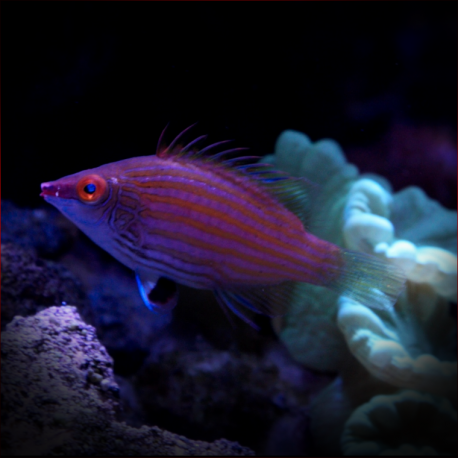More info
Datasheet
| Minimum Tank Size | 50 litres / 13.21 US gallons |
| Maximum Size | 6.0cm / 2.36inches |
| Reef Compatible | Always reef safe |
| Temperament | Mostly peaceful but might be aggressive towards similar species |
| Temperature | 22.2°C / 71.96°F - 25.6°C / 78.08°F |
| Specific Gravity | 1.020-1.025 |
| Carbonate Hardness | 8-12 |
| pH | 8.1-8.4 |
General Description
The Pelvic-spot wrasse, also known as the Pink-streaked wrasse, belongs to the Labridae family, specifically Pseudocheilinops. This species is usually found in the Western Central Pacific, ranging from the southern Philippines to Palau. Wrasses, in general, are popular in reef aquariums due to their attractive appearance and their ability to help control populations of unwanted invertebrates such as flatworms and pyramid snails. They have a varied diet, ranging from zooplankton to larger crustaceans and sea urchins.
Aquarium Suitability
The Pelvic-spot wrasse is suitable for most aquarium setups, though it is recommended to house them in tanks larger than 50 liters to adequately meet their needs. These fish can be kept in smaller tanks if properly equipped to cater to their requirements.
Demands, Care, and Hardiness
This species has an average level of hardiness and thrives in water conditions with a pH of 8.1-8.4, a KH of 8-12, specific gravity between 1.020-1.025, and a temperature range of 22.2-25.6°C. They require frequent feeding, especially when first introduced into the aquarium, but can feed less often when natural food sources are available. Additionally, the Pelvic-spot wrasse benefits from good hiding places like live rocks in the tank.
Reef Suitability
The Pelvic-spot wrasse is consistently reef-safe, making it an excellent choice for reef aquariums. However, its temperament may include some aggression towards similar species.
Aquarium Setup
To ensure the well-being of the Pelvic-spot wrasse, provide ample hiding spots like live rocks for shelter. Maintaining stable water parameters within the specified ranges and offering a varied diet of small crustaceans and zooplankton will help keep this species healthy and thriving in captivity.
Behaviour
These wrasses are mostly peaceful but may display aggression towards other fish of the same species. Their behavior can also include gender changes from female to male as needed.
Feeding and Diet
The recommended diet for the Pelvic-spot wrasse includes small crustaceans like krill, mysis, and artemia, as well as zooplankton such as cyclops and pods. Feeding several times a day is beneficial for their well-being.
Dimorphism and Captive Reproduction
The Pelvic-spot wrasse is hermaphroditic, with the ability to change gender from female to male. In captivity, breeding and reproduction have been observed, adding to the fascinating behavior of this species.
Habitat and Distribution
In the wild, the Pelvic-spot wrasse is found in the waters of Indonesia and the Central/Western Pacific, specifically ranging from the southern Philippines to Palau. Its habitat includes coral reefs where it can seek shelter and forage for food in the crevices and among the rocky structures.

